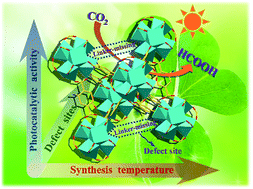Temperature modulation of defects in NH2-UiO-66(Zr) for photocatalytic CO2 reduction
Abstract
Defect engineering can be a promising approach to improve the photocatalytic performance of metal–organic frameworks (MOFs). Herein, a series of defective NH2-UiO-66(Zr) materials were synthesized via simply controlling the synthesis temperature, with concentrated HCl as the modulator and then these as-prepared samples were used to systematically investigate the effects of their structural defects on photocatalytic CO2 reduction. Remarkably, these MOFs with defects exhibit significantly enhanced activities in photocatalytic CO2 reduction, compared with the material without defects. The defect engineering creates active binding sites and more open frameworks in the MOF, and thus facilitates the photo-induced charge transfer and restrains the recombination of photo-generated charges efficiently. The current work provides an instructive approach to improve the photocatalytic efficiency by taking advantage of the structural defects in MOFs, and could also inspire more work on the design of advanced defective MOFs.



 Please wait while we load your content...
Please wait while we load your content...